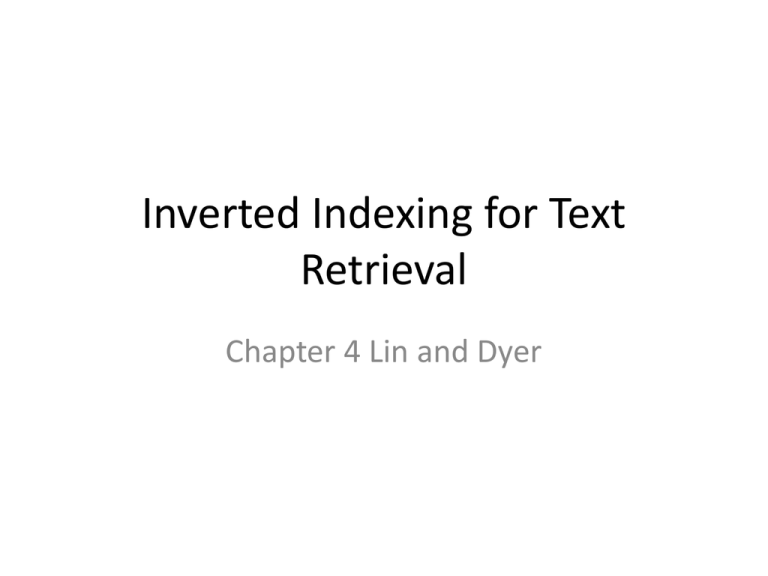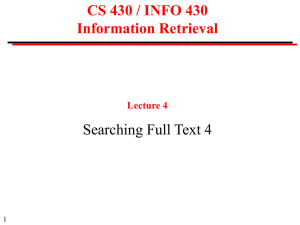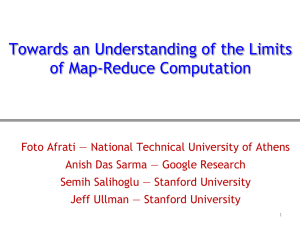Inverted Indexing for Text Retrieval
advertisement

Inverted Indexing for Text
Retrieval
Chapter 4 Lin and Dyer
Introduction
• Web search is a quintessential large-data problem.
• So are any number of problems in genomics.
– Google, amazon (aws) all are involved in research and
discovery in this area
• Web search or full text search depends on a data
structure called inverted index.
• Web search problem breaks down into three major
components:
– Gathering the web content (crawling) (project 1)
– Construction of inverted index (indexing) (project 2)
– Ranking the documents given a query (retrieval) (exam 2)
Issues with these components
• Crawling and indexing have similar
characteristics: resource consumption is high
• Retrieval is very different from these: spikey,
variability is high, quick response is a
requirement, many concurrent users;
• There are many requirements for a web
crawler or in general a data aggregator..
– Etiquette, bandwidth resources, multilingual,
duplicate contents, frequency of changes…
Inverted Indexes
• Regular index: Document terms
• Inverted index termdocuments
• Example:
term1 {d1,p}, {d2, p}, {d23, p}
term2 {d2, p}. {d34, p}
term3 {d6, p}, {d56, p}, {d345, p}
Where d is the doc id, p is the payload (example for
payload: term frequency… this can be blank too)
Retrieval
• Once the inverted index is developed, when a
query comes in, retrieval involves fetching the
appropriate docs.
• The docs are ranked and top k docs are listed.
• It is good to have the inverted index in memory.
• If not , some queries may involve random disk
access for decoding of postings.
• Solution: organize the disk accesses so that
random seeks are minimized.
Pseudo Code
Pseudo code Baseline implementation
value-key conversion pattern
implementation…
Baseline implementation
procedure map (docid n, doc d)
H new Associative array
for all terms in doc d
H{t} H{t} + 1
for all term in H
emit(term t, posting <n, H{t}>)
Reducer for baseline implmentation
procedure reducer( term t, postings[<n1, f1> <n2, f2>, …])
P new List
for all posting <a,f> in postings
Append (P, <a,f>)
Sort (P) // sorted by docid
Emit (term t, postings P)
Shuffle an sort phase
• Is a very large group by term of the postings
• Lets look at a toy example
• Fig. 4.3 some items are incorrect in the figure
Revised Implementation
• Issue: MR does not guarantee sorting order of
the values.. Only by keys
• So the sort in the reducer is an expensive
operation esp. if the docs cannot be held in
memory.
• Lets check a revised solution
• (term t, posting<docid, f>) to
• (term<t,docid>, tf f)
Modified mapper
Map (docid n, doc d)
H new AssociativeArray
For all terms t in doc
H{t} H{t} + 1
For all terms in H
emit (tuple<t,n>, H{t})
Modified Reducer
Initialize
tprev 0
P new PostingList
method reduce (tuple <t,n>, tf [f1, ..])
if t # tprev ^ tprev # 0
{ emit (term t, posting P);
reset P; }
P.add(<n,f>)
tprev t
Close
emit(term t, postings P)
Other modifications
• Partitioner and shuffle have to deliver all
related <key, value> to same reducer
• Custom partitioner so that all terms t go to
the same reducer.
• Lets go through a numerical example
From Yahoo site











